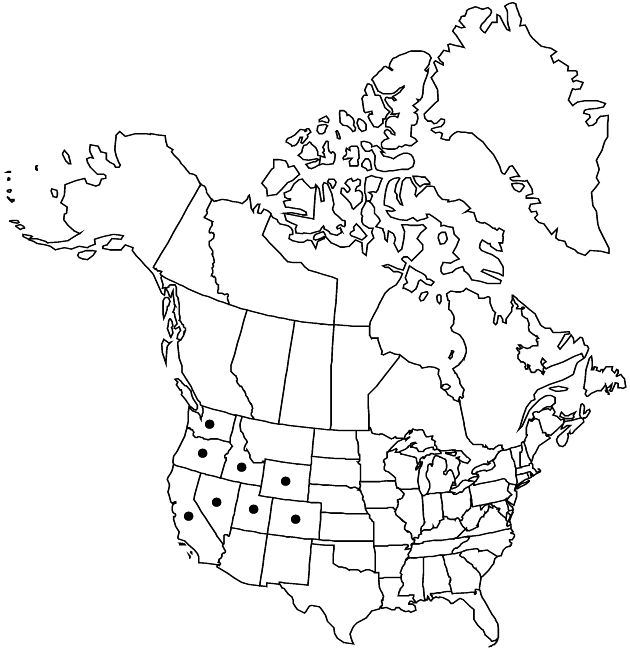Difference between revisions of "Artemisia spiciformis"
Bull. Torrey Bot. Club 27: 507. 1900.
FNA>Volume Importer |
imported>Volume Importer |
||
| (6 intermediate revisions by 2 users not shown) | |||
| Line 8: | Line 8: | ||
}} | }} | ||
|common_names=Snowfield sagebrush | |common_names=Snowfield sagebrush | ||
| + | |special_status={{Treatment/ID/Special_status | ||
| + | |code=E | ||
| + | |label=Endemic | ||
| + | }} | ||
|basionyms= | |basionyms= | ||
|synonyms={{Treatment/ID/Synonym | |synonyms={{Treatment/ID/Synonym | ||
|name=Artemisia tridentata subsp. spiciformis | |name=Artemisia tridentata subsp. spiciformis | ||
|authority=(Osterhout) Kartesz & Gandhi | |authority=(Osterhout) Kartesz & Gandhi | ||
| − | }}{{Treatment/ID/Synonym | + | |rank=subspecies |
| + | }} {{Treatment/ID/Synonym | ||
|name=Seriphidium spiciforme | |name=Seriphidium spiciforme | ||
|authority=(Osterhout) Y. R. Ling | |authority=(Osterhout) Y. R. Ling | ||
| + | |rank=species | ||
}} | }} | ||
|hierarchy=Asteraceae;Asteraceae tribe Anthemideae;Artemisia;Artemisia subg. Tridentatae;Artemisia spiciformis | |hierarchy=Asteraceae;Asteraceae tribe Anthemideae;Artemisia;Artemisia subg. Tridentatae;Artemisia spiciformis | ||
| Line 30: | Line 36: | ||
|elevation=2100–3700 m | |elevation=2100–3700 m | ||
|distribution=Calif.;Colo.;Idaho;Nev.;Oreg.;Utah;Wash.;Wyo. | |distribution=Calif.;Colo.;Idaho;Nev.;Oreg.;Utah;Wash.;Wyo. | ||
| − | |discussion=<p>Often confused with Artemisia rothrockii, A. spiciformis has been recognized only recently as a widespread, high-elevation sagebrush of late-lying snowfields. Molecular analysis has not yet determined the degree to which this species intergrades with A. cana subsp. viscidula and A. tridentata subsp. vaseyana, the presumed parents of this putative hybrid. Because snow-field sagebrush produces fertile seeds and forms a stable community type, it is treated here as a distinct species.</p> | + | |discussion=<p>Often confused with <i>Artemisia rothrockii</i>, <i>A. spiciformis</i> has been recognized only recently as a widespread, high-elevation sagebrush of late-lying snowfields. Molecular analysis has not yet determined the degree to which this species intergrades with <i>A. cana </i>subsp.<i> viscidula</i> and <i>A. tridentata </i>subsp.<i> vaseyana</i>, the presumed parents of this putative hybrid. Because snow-field sagebrush produces fertile seeds and forms a stable community type, it is treated here as a distinct species.</p> |
|tables= | |tables= | ||
|references= | |references= | ||
| Line 39: | Line 45: | ||
-->{{#Taxon: | -->{{#Taxon: | ||
name=Artemisia spiciformis | name=Artemisia spiciformis | ||
| − | |||
|authority=Osterhout | |authority=Osterhout | ||
|rank=species | |rank=species | ||
| Line 53: | Line 58: | ||
|publication title=Bull. Torrey Bot. Club | |publication title=Bull. Torrey Bot. Club | ||
|publication year=1900 | |publication year=1900 | ||
| − | |special status= | + | |special status=Endemic |
| − | |source xml=https:// | + | |source xml=https://bitbucket.org/aafc-mbb/fna-data-curation/src/2e0870ddd59836b60bcf96646a41e87ea5a5943a/coarse_grained_fna_xml/V19-20-21/V19_875.xml |
|tribe=Asteraceae tribe Anthemideae | |tribe=Asteraceae tribe Anthemideae | ||
|genus=Artemisia | |genus=Artemisia | ||
Latest revision as of 20:57, 5 November 2020
Shrubs, 30–80 cm (widely branched, gray-tomentose), aromatic; root-sprouting. Stems relatively numerous, brown or grayish green. Leaves ± deciduous (by late summer, turning yellow); blades lanceolate, oblanceolate, or cuneate, 2.5–5.5 × 0.8–1.2+ cm, entire or irregularly 3–6-lobed (lobes to 1/3 blade lengths, 1.5+ mm wide, rounded or acute; leaves of flowering stems usually smaller, entire), faces ± sericeous or tomentose. Heads (erect) in (leafy) paniculiform arrays 8–15(–25) × 0.5–3(–4) cm. Involucres ovoid or lanceoloid, (2.5–)4–6(–7) mm. Phyllaries lanceolate, sparsely to densely hairy. Florets 8–18(–27); corollas 2.5–3.5, glabrous. Cypselae 1–1.5 mm, glabrous or resinous. 2n = 18, 36, 54, 72.
Phenology: Flowering mid summer–fall.
Habitat: Moist open slopes, rocky meadows, streamsides, woodlands, late-lying snowfields
Elevation: 2100–3700 m
Distribution

Calif., Colo., Idaho, Nev., Oreg., Utah, Wash., Wyo.
Discussion
Often confused with Artemisia rothrockii, A. spiciformis has been recognized only recently as a widespread, high-elevation sagebrush of late-lying snowfields. Molecular analysis has not yet determined the degree to which this species intergrades with A. cana subsp. viscidula and A. tridentata subsp. vaseyana, the presumed parents of this putative hybrid. Because snow-field sagebrush produces fertile seeds and forms a stable community type, it is treated here as a distinct species.
Selected References
None.